Overview
In the realm of software development, developers frequently encounter challenges related to code complexity. The McCabe complexity measure stands out as a pivotal tool that addresses these challenges, significantly enhancing code quality and maintainability. By employing this measure, developers can pinpoint intricate areas within their code, which in turn facilitates the implementation of more effective testing strategies. This proactive approach not only reduces defects but also streamlines development processes, leading to greater efficiency overall.
Furthermore, the application of the McCabe complexity measure empowers developers to adopt a more structured approach to coding. By identifying problematic sections, teams can prioritize their efforts, ensuring that critical areas receive the attention they deserve. In addition, this measure fosters better collaboration among team members, as it provides a clear framework for discussing code quality and maintainability.
Ultimately, leveraging the McCabe complexity measure can lead to substantial improvements in productivity and code quality. Developers who embrace this tool will find themselves equipped to tackle the complexities of modern software development with confidence. Are you ready to elevate your coding practices and enhance your development outcomes?
Introduction
In the fast-evolving landscape of software development, developers encounter significant challenges related to maintaining code quality amidst increasing complexity. How can teams effectively navigate this intricate environment? Metrics such as cyclomatic complexity and McCabe metrics emerge as essential tools for developers striving to enhance their coding practices. By quantifying the intricacies of code, these metrics provide invaluable insights that guide refactoring, testing strategies, and overall project efficiency.
Furthermore, with the advent of AI-driven solutions like Kodezi, developers are empowered to streamline their workflows. Kodezi automatically analyzes and optimizes code, mitigating defects and bolstering maintainability. Imagine being able to focus more on innovation while Kodezi handles the heavy lifting of code analysis. This article delves into the significance of these metrics, exploring practical applications and strategies that can transform the development process into a more robust and productive endeavor.
In addition, utilizing Kodezi not only enhances productivity but also elevates code quality. Are you ready to explore the tools available on the platform? Discover how Kodezi can revolutionize your coding practices and lead to a more efficient development process.
Kodezi | Professional OpenAPI Specification Generator - AI Dev-Tool: Enhance Code Quality with McCabe Metrics
Coding challenges are a common hurdle for developers, often leading to inefficiencies and frustration. Kodezi offers a powerful set of tools that seamlessly integrate the McCabe complexity measure, significantly elevating software standards. By utilizing the Professional OpenAPI Specification Generator, developers can ensure their APIs are not only well-documented but also compliant with industry standards. The incorporation of the McCabe complexity measure allows for real-time analysis of software complexity, enabling developers to pinpoint areas that require optimization. This proactive approach not only enhances program maintainability but also fosters better collaboration among team members by providing clear insights into structure and standards.
Moreover, Kodezi's AI-driven automated builds and testing streamline changes made by developers throughout the software development lifecycle, ensuring that issues are identified before they escalate. Recent case studies demonstrate that development teams using the McCabe complexity measure have effectively monitored and managed software intricacy, leading to improved API documentation and overall software standards. For example, teams have reported that by implementing effective measurement strategies, they could adapt their development processes based on complexity-related considerations rather than arbitrary limits, resulting in a more efficient development process. Industry leaders, such as John Ousterhout, emphasize the importance of these metrics, stating, "You’ll end up with a much better result if you consider multiple options for each major design decision." This underscores the critical role of the McCabe complexity measure in facilitating informed decision-making.
Furthermore, the iterative nature of quality enhancement is highlighted by the idea that progress stems from learning from errors and iterating based on feedback. With Kodezi CLI, an autonomous solution tailored for B2B engineering teams, developers are empowered to elevate their coding practices through informed decision-making and collaboration, surrounding themselves with talented individuals to achieve superior outcomes. Are you ready to transform your coding experience? Explore the tools available on Kodezi's platform today!
Understanding Cyclomatic Complexity: Definition and Importance
Coding challenges are a common hurdle that developers face, often leading to increased complexity and maintenance issues. The cyclomatic intricacy, known as the McCabe complexity measure and introduced by Thomas McCabe in 1976, quantifies this difficulty by counting the number of linearly independent paths through a program's source text. The control flow graph serves as the foundation for this calculation, where each decision point contributes to the overall difficulty score. Understanding these intricacies is crucial, as they directly impact program maintainability and testability.
So, how can developers tackle these challenges? Enter Kodezi, an AI-driven programming assistant designed to simplify the coding process. Kodezi automatically analyzes bugs, optimizes scripts, and generates comments, significantly reducing cyclomatic complexity and enhancing overall quality. Unlike competitors like Copilot, which primarily focus on code completion, Kodezi acts as an autocorrect feature for programming, enabling users to debug and resolve coding problems effortlessly.
The benefits of using Kodezi are clear. Projects that have successfully lowered their control flow intricacy, as indicated by the McCabe complexity measure, have reported substantial improvements in maintainability. This not only boosts programming standards but also enhances overall efficiency. As an industry specialist noted, "Reducing it through techniques such as refactoring, simplifying control structures, and encouraging reusability can result in more efficient and maintainable software systems."
Furthermore, it’s essential to consider the context of programming applications. High cyclomatic intricacy may indicate potential concerns with programming standards, but it does not always signify a problem, as illustrated in the case study titled 'False Positives.' This underscores the necessity for a nuanced assessment of software quality.
Are you ready to explore how Kodezi can transform your coding experience? Discover the tools available on the platform and take the first step towards improved productivity and code quality.
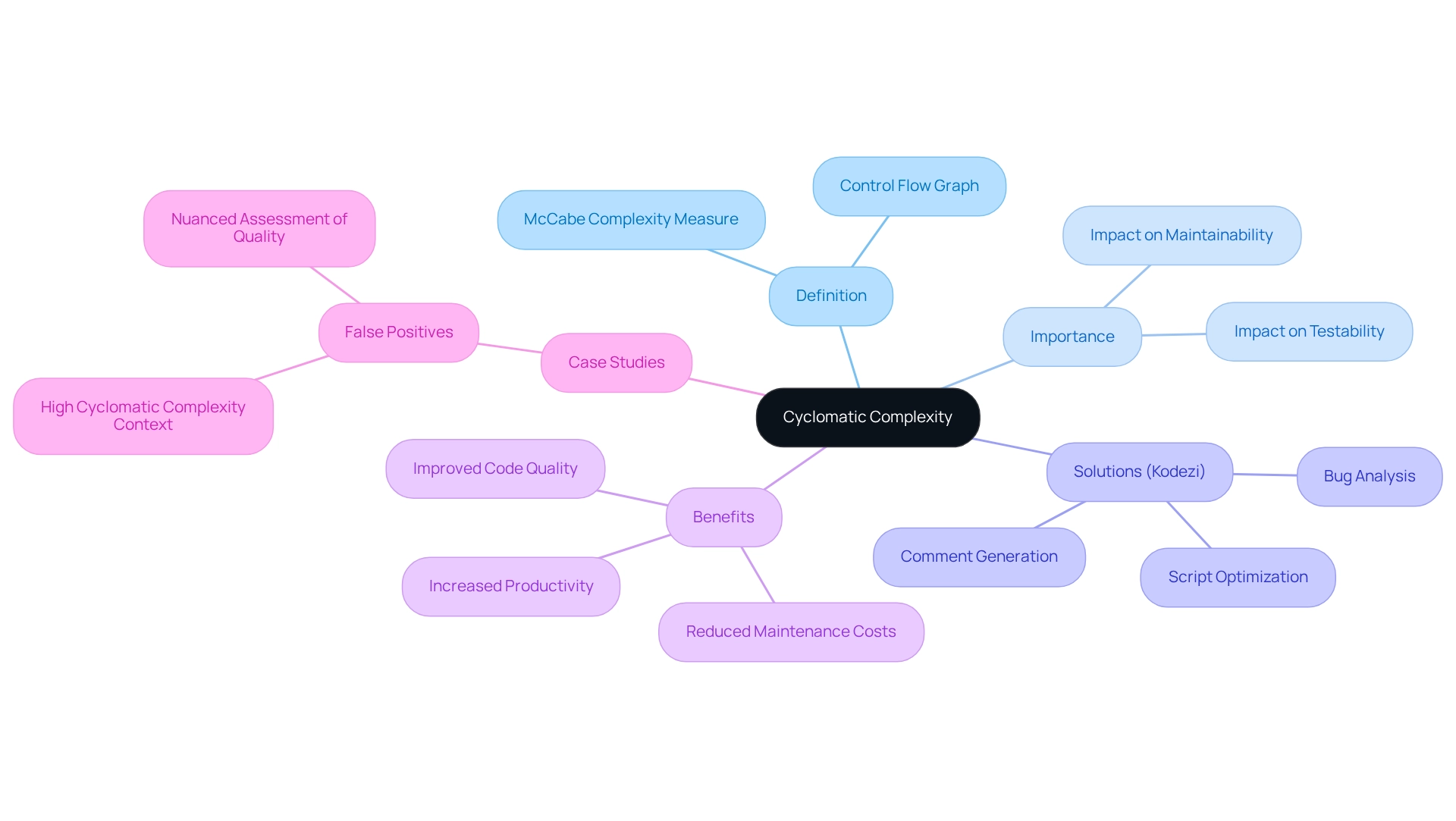
Interpreting McCabe Metrics: Practical Applications for Developers
Developers often face significant challenges in managing program intricacy and enhancing code quality. The McCabe complexity measure provides a valuable tool for assessing these complexities, allowing for the identification of areas within the codebase that could benefit from restructuring. By analyzing the control flow of functions, developers can enhance clarity and sustainability, ultimately fostering a culture focused on quality. Integrating these metrics into continuous integration (CI) pipelines allows teams to consistently monitor software standards, ensuring that new contributions adhere to predefined intricacy benchmarks.
For instance, a case study on incorporating cyclomatic complexity in unit testing demonstrated that developers who measured complexity and designed targeted test cases significantly improved software quality, achieving a remarkable 30% reduction in bug reports. Furthermore, teams utilizing the McCabe complexity measure in their CI/CD pipelines experience a 25% enhancement in clarity and maintainability, paving the way for long-term software success. Automated reports generated by static analysis tools enable teams to prioritize improvement areas based on these metrics.
In this context, integrating Kodezi CLI into development workflows can further amplify these efforts. As an independent solution, Kodezi CLI assists in recognizing intricate programming segments while actively enhancing software repositories and resolving issues before they reach production. Developers can quickly get started with Kodezi CLI through a 5-minute quickstart and view a demo to better understand its capabilities. This synergy between the McCabe complexity measure, McCabe metrics, and Kodezi CLI empowers developers to maintain a clean, scalable, and maintainable codebase. Ongoing efforts in managing cyclomatic intricacy, supported by Kodezi CLI, are crucial for improving code quality and delivering robust software.
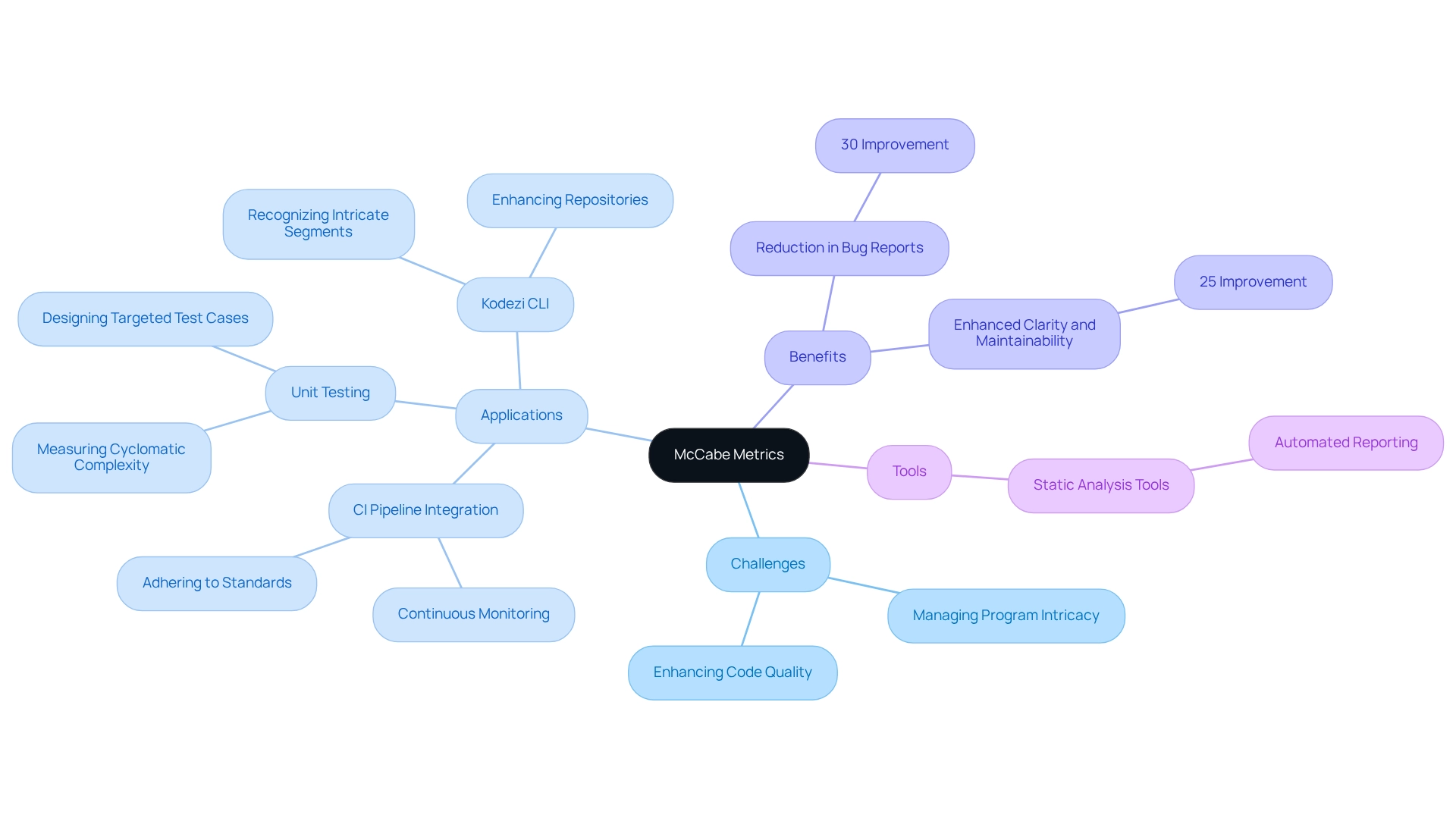
Implications of Cyclomatic Complexity for Software Testing
Coding challenges often arise from the complexities of software development, particularly in testing strategies. The McCabe complexity measure plays a crucial role in this context. Functions with heightened difficulty scores necessitate a greater number of test cases to ensure thorough coverage of all possible execution paths. Consequently, prioritizing testing for these high-complexity functions is essential for effectively mitigating defect risks.
Furthermore, by utilizing control flow metrics, QA teams can enhance resource distribution. This allows them to focus their efforts on critical areas that require comprehensive review. Such an approach not only boosts testing efficiency but also aids in identifying high-risk segments within the code that warrant additional scrutiny during the testing phase. For instance, a value of the McCabe complexity measure exceeding 10 typically indicates the need for enhanced testing emphasis, as these scores are associated with elevated defect rates.
In addition, by understanding and applying these insights, teams can significantly improve their testing outcomes and overall software quality. As noted, "By identifying modules with high difficulty, teams can focus on crucial areas for refactoring, thus minimizing potential points of failure and enhancing the system's overall strength." Moreover, findings from the case study titled 'Key Features of SMART TS XL for Managing Code Complexity' emphasize how effective oversight of code intricacy can enhance development cycles and minimize technical debt.
By integrating these strategies, teams can elevate their testing frameworks and ensure robust software performance. Are you ready to explore how these insights can transform your approach to software testing?
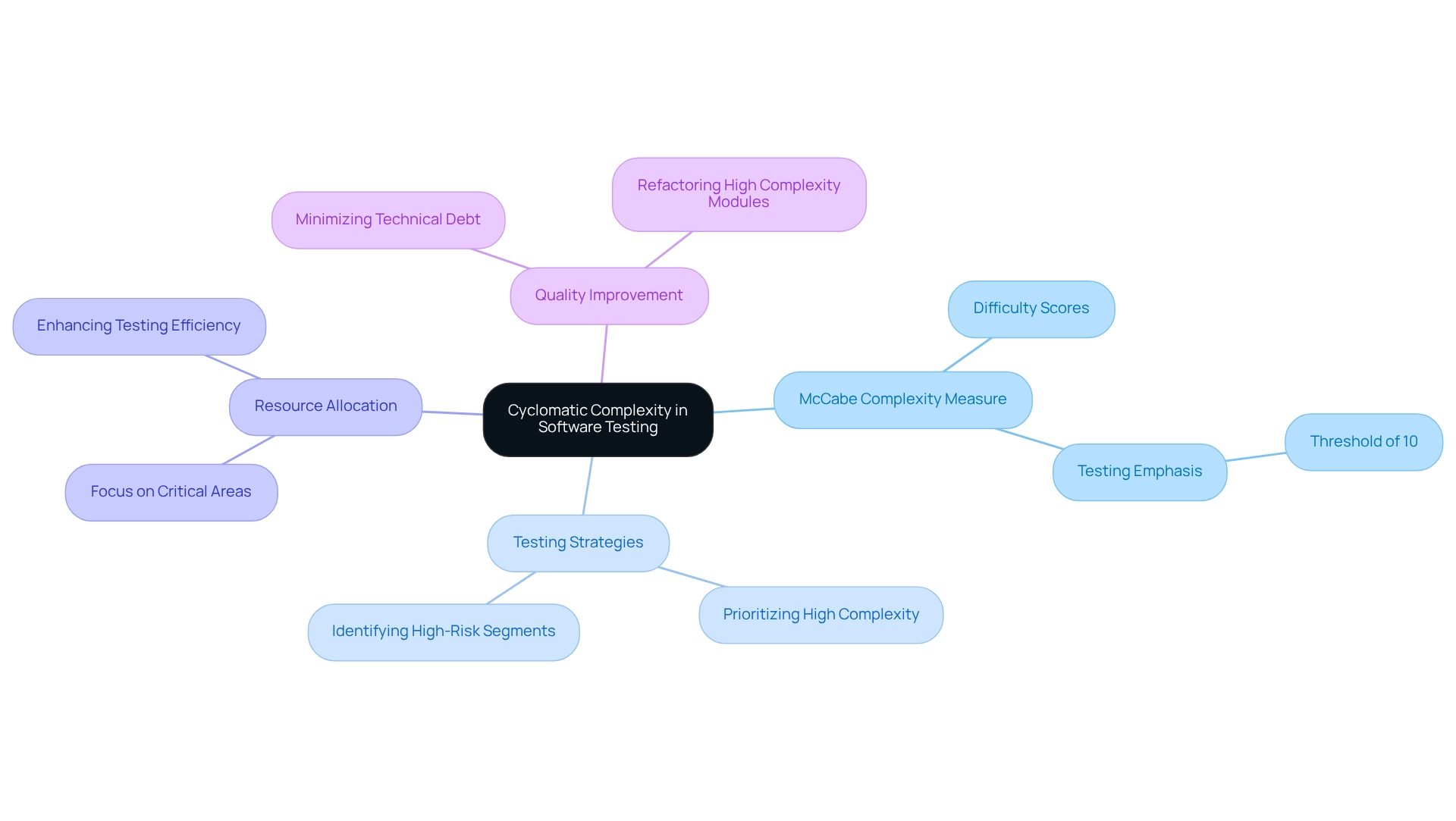
Correlation Between Cyclomatic Complexity and Defect Rates
In software development, the intricacy of control flow presents significant challenges for developers. Studies have consistently shown a notable relationship between control flow intricacy and defect rates. Code with high structural intricacy is often more susceptible to errors due to its elaborate design and numerous decision points. As cyclomatic intricacy rises, the probability of defects increases, underscoring the importance for developers to carefully observe and manage the McCabe complexity measure within their codebases.
A recent study titled 'Correlation between Code Intricacy and Bugs' revealed that while simple bugs show no strong correlation with path intricacy, complex real-world bugs exhibit a notable relationship. This finding suggests that the McCabe complexity measure can serve as a valuable metric in bug prediction models and test generation strategies. Furthermore, approximately 65% of developers utilize linters to enforce coding standards, which can significantly reduce bugs and enhance maintainability.
Tools like Kodezi CLI can further assist in this area by independently examining scripts, identifying intricate sections, and offering automatic corrections. This proactive approach enhances code quality before it reaches production. As Rafael Timbó, Chief Technology Officer, advises, "Report the results: Present the results of your analysis clearly and concisely, highlighting areas of the code that are particularly complex or difficult to understand."
By actively managing cyclomatic intricacy with the help of Kodezi, development teams can reduce the risk of defects. This not only enhances overall software reliability but also improves code quality, ultimately leading to increased productivity. Are you ready to explore how Kodezi can transform your coding practices?
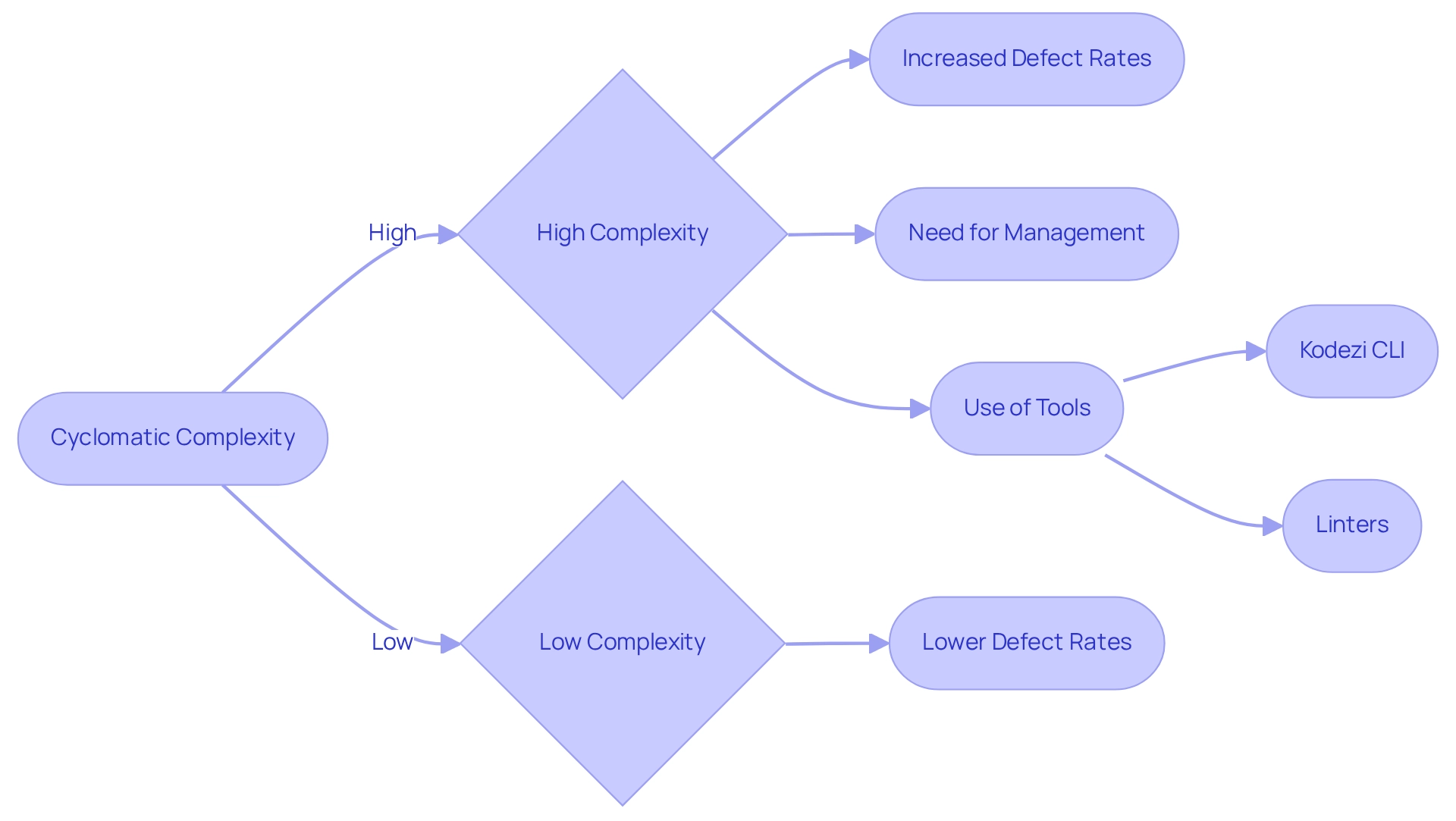
Limiting Complexity During Development: Strategies for Success
In the realm of software development, developers often encounter intricate challenges that can hinder their progress. To effectively reduce this intricacy, several key strategies can be employed, with tools like Kodezi CLI significantly enhancing these efforts.
Firstly, crafting smaller, focused functions that accomplish a single task is crucial. This approach minimizes decision points and clarifies control flow, ultimately improving the program's readability. For instance, a function with two potential execution paths has a measurement of intricacy valued at 2, illustrating how even straightforward structures can impact complexity.
Furthermore, adopting design patterns such as the Single Responsibility Principle ensures that each component of the codebase serves a distinct purpose. This simplification aids in maintenance and reduces the risk of defects. A case study titled 'Risk of Defects Associated with Cyclomatic Complexity' underscores that intricate programming, particularly when frequently modified, is more susceptible to flaws according to the McCabe complexity measure. This reinforces the importance of minimizing intricacy and turnover in development processes.
Regular programming evaluations are essential for identifying complexity issues early on. Research indicates that organized program evaluations can significantly lower the McCabe complexity measure, leading to fewer flaws and enhanced software quality. Additionally, prioritizing refactoring sessions allows teams to proactively address challenges before they escalate. Here, Kodezi CLI can autonomously improve the codebase and rectify bugs prior to production, further elevating code quality.
Fostering a culture that values simplicity and clarity is paramount. By establishing intricacy thresholds, teams can cultivate an environment that promotes excellence in coding practices. As Faraz Ansari, a Senior Software Engineer, aptly states, 'The number of regions is equivalent to the intricacy,' highlighting the importance of understanding this metric.
Visual aids, such as flowcharts, can also aid in grasping control flow and calculating its intricacy. These representations help convey complex concepts within the team, facilitating a deeper understanding of the impacts of structure.
Ultimately, these strategies not only enhance the maintainability of codebases but also contribute to a more efficient development process. This decreases the likelihood of misunderstandings and defects associated with high code structure. With Kodezi CLI as a versatile tool, teams can auto-heal their codebases and boost programming productivity, ensuring a smoother development journey. For those interested in getting started, a 5-minute quickstart is available, along with a demo to explore Kodezi CLI's capabilities in action.
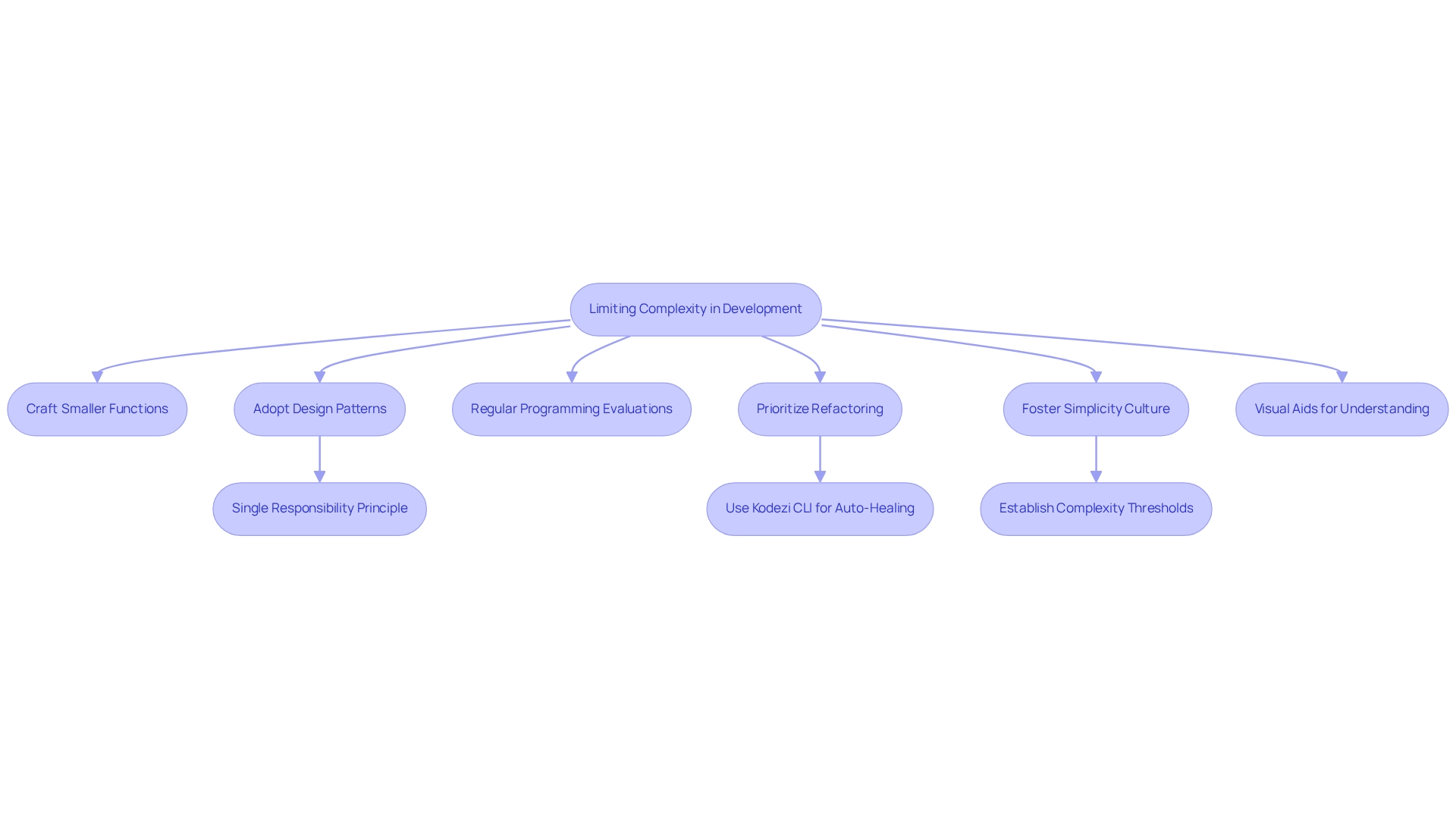
Measuring Program Structuredness: A Key Aspect of McCabe Metrics
Measuring the structuredness of a program is crucial when using the McCabe complexity measure. Have you ever faced challenges in coding that affect clarity and maintainability? Structuredness reflects how effectively the program adheres to structured programming principles, which are essential for clarity and maintainability. Programs that are well-structured typically demonstrate lower cyclomatic complexity, as they reduce unnecessary branching and decision points. Developers can evaluate structuredness by analyzing control flow graphs and ensuring adherence to best practices in modular design.
Furthermore, Kodezi's automated debugging feature enables developers to quickly recognize and address issues in the codebase. This tool offers detailed explanations and insights into what went wrong and how it was resolved. By utilizing Kodezi, not only can you resolve performance bottlenecks and improve formatting, but you also guarantee adherence to the latest security best practices.
In addition, a recent study examining 862,517 Java classes from 1,000 open GitHub repositories uncovered a strong correlation (Pearson correlation of 0.79) between cyclomatic intricacy and response for class (RFC). This indicates that smaller classes with fewer methods improve maintainability. The linear regression equation derived from the analysis is CC = 0.58 * RFC + 2.11, providing a quantitative understanding of this relationship. By prioritizing structuredness and leveraging tools like Kodezi, teams can produce software that is not only easier to comprehend but also more adaptable to future changes, ultimately leading to improved project outcomes.
As Thomas J. McCabe mentioned, "By dissecting our programming systematically like this, we clarify what’s necessary for software evaluation and emphasize the intricacy in our programming as indicated by the McCabe complexity measure." This viewpoint emphasizes the significance of organized programming principles in minimizing the intricacy of code. However, it is worth noting that the study faced criticism regarding the appropriateness of using different correlation coefficients, which highlights the need for careful interpretation of the findings. Are you ready to enhance your coding practices with Kodezi?
Calculating McCabe Metrics: A Step-by-Step Guide
Calculating the McCabe complexity measure is a simple yet vital process for evaluating program intricacy. Developers often encounter challenges in managing complex code. How can they effectively assess and improve their programming practices? One solution lies in evaluating cyclomatic intricacy through a straightforward method.
To assess cyclomatic intricacy, follow these steps:
- Construct a Control Flow Graph: Begin by mapping out the program's control flow, identifying nodes (decision points) and edges (paths between nodes).
- Count the Elements: Tally the number of edges (E), nodes (N), and connected components (P) in your graph.
- Apply the Formula: Use the formula: Cyclomatic Complexity (CC) = E - N + 2P. This calculation produces a numerical value that represents the intricacy of the program, allowing developers to assess and oversee the standard of the software efficiently.
The necessity for clear and concise programming is essential in contemporary software development. Regular evaluations of these metrics are vital for teams striving to maintain a clear comprehension of their program's intricacy over time. For instance, teams that have applied cyclomatic intricacy assessments have reported substantial enhancements in software quality, showcasing the practical advantages of this method. As noted in industry discussions, the key to efficient development lies in learning from mistakes. Larry Wall aptly observed that the virtues of a programmer include laziness, impatience, and hubris—an attitude crucial when handling programming intricacies.
Furthermore, tools such as Kodezi, with its AI-driven functions, enable smoother project transitions through effortless programming translation and automatic bug assessment. The Kodezi CLI can also 'AutoHeal codebases,' demonstrating how the McCabe complexity measure can enhance flexibility for developers. To implement these concepts effectively, consider setting aside time in your development cycle to regularly assess the McCabe complexity measure. This practice ensures that your work remains manageable and high-quality.
By leveraging Kodezi, you can further enhance your programming productivity and coding skills. Don't miss the chance to explore Kodezi's free trials and demos, which can significantly enhance the process of maintaining programming standards.
Automated Testing in Agile Development: Enhancing Code Quality with McCabe Metrics
Developers often face significant coding challenges that can impact software quality. Incorporating the McCabe complexity measure into automated testing procedures within agile development addresses these issues effectively. By integrating the McCabe complexity measure assessments into continuous integration workflows, teams can automatically evaluate the complexity of new submissions. This prompt feedback system allows developers to tackle potential problems before they escalate, fostering a proactive approach to software excellence.
Furthermore, automated testing frameworks can leverage these metrics to prioritize test cases. This ensures that the most intricate and potentially problematic areas of the software receive thorough scrutiny. Such a strategy not only enhances testing efficiency but also nurtures a culture of quality and continuous improvement among agile teams. Routine assessment and evaluation of structural intricacy serve as a valuable guide for developers, helping them identify areas prone to errors or difficult to manage, ultimately contributing to the development of high-quality software.
In addition, automated static software analysis tools can suggest modifications to reduce complexity, providing practical assistance to developers. As noted in the NIST Structured Testing methodology, employing control flow metrics to determine the necessary number of white-box tests is a typical and effective approach. Findings from the case study titled 'Importance of Cyclomatic Complexity in Software Development' highlight that maintaining a low level of intricacy enables developers to ensure their programming remains efficient and manageable, which is critical for overall software performance.
How can adopting these practices transform your coding experience?
The Significance of McCabe Complexity Measures in Software Development
Coding challenges are a significant hurdle for developers, particularly as software projects become increasingly complex. The McCabe complexity measure provides a quantitative framework to evaluate program intricacy, enabling teams to effectively manage cyclomatic complexity. By doing so, developers can significantly enhance the quality of their work, improve maintainability, and minimize the risk of defects. These metrics not only inform testing strategies but also strengthen program structure, fostering a culture of excellence within development teams.
Have you considered how Kodezi can help address these challenges? Teams that have integrated the McCabe complexity measure into their workflows, alongside tools like Kodezi, report marked improvements in programming standards and a reduction in technical debt. Users have shared their experiences, noting that Kodezi's commenting feature and bug-fixing capabilities allow for quicker and easier issue resolution compared to manual methods. One user from the Massachusetts Institute of Technology remarked, "Kodezi has drastically improved our engineering team’s productivity and allowed us to focus on higher-level tasks."
Furthermore, a recent study highlights that cyclomatic complexity (CC) lacks explanatory power when viewed in isolation. It suggests that CC should be analyzed alongside lines of code (LOC) to gain a comprehensive understanding of code quality. This dual approach enables teams to manage the complexities of modern software development more effectively, as both CC and LOC assess the same attributes. Industry leaders stress that employing complexity metrics is essential for maintaining clean, scalable, and maintainable codebases, ultimately leading to more efficient development processes.
As we approach 2025, the adoption of the McCabe complexity measure continues to grow, reinforcing its significance in shaping effective testing strategies and enhancing overall software quality. Additionally, case studies like "Seamless Code Translation with Kodezi" showcase the practical application of these metrics, empowering developers to operate across various environments without significant overhead. As one software engineer expressed, "I love what Kodezi is doing with debugging; it feels like I just unlocked a new superpower!
Conclusion
In the fast-paced realm of software development, managing code complexity presents significant challenges for developers. How can teams ensure high-quality outputs amidst these complexities? The application of metrics like cyclomatic complexity and McCabe metrics offers actionable insights that enhance decision-making, improve code readability, and ultimately boost maintainability. By measuring and analyzing these metrics, teams can pinpoint areas needing refactoring, streamline testing strategies, and foster a culture centered on quality.
Furthermore, the introduction of AI-driven solutions such as Kodezi elevates these practices to new heights. By automating code analysis and optimization, Kodezi empowers developers to concentrate on innovation while efficiently tackling technical challenges. The synergy between McCabe metrics and Kodezi's capabilities not only mitigates the risks associated with high complexity but also enhances overall productivity and code quality.
As the software landscape evolves, integrating these metrics into development workflows becomes increasingly vital. Embracing tools like Kodezi ensures that teams can effectively navigate the complexities of modern coding environments, paving the way for robust, maintainable, and scalable software solutions. The journey towards improved coding practices is ongoing, and the tools available today, such as Kodezi, are essential allies in achieving excellence in software development. Are you ready to explore the benefits that Kodezi can bring to your coding practices?
Frequently Asked Questions
What are coding challenges and how do they affect developers?
Coding challenges are obstacles that developers frequently encounter, leading to increased complexity and maintenance issues within their software projects.
What is the McCabe complexity measure?
The McCabe complexity measure, introduced by Thomas McCabe in 1976, quantifies the complexity of a program by counting the number of linearly independent paths through its source code, using a control flow graph for calculation.
How does Kodezi help developers manage coding challenges?
Kodezi is an AI-driven programming assistant that simplifies the coding process by automatically analyzing bugs, optimizing scripts, and generating comments, which can reduce cyclomatic complexity and enhance overall software quality.
What benefits have projects experienced by lowering their control flow intricacy?
Projects that have successfully reduced their control flow intricacy have reported significant improvements in maintainability and overall efficiency.
Can high cyclomatic complexity always be considered a problem?
High cyclomatic complexity may indicate potential concerns with programming standards, but it does not always signify a problem, as shown in case studies that highlight the need for nuanced assessments of software quality.
How does Kodezi integrate with continuous integration (CI) pipelines?
Kodezi can be integrated into CI pipelines to consistently monitor software standards and ensure that new contributions adhere to predefined complexity benchmarks.
What improvements have teams experienced by utilizing the McCabe complexity measure in their CI/CD pipelines?
Teams using the McCabe complexity measure in their CI/CD pipelines have seen a 25% enhancement in clarity and maintainability, along with a 30% reduction in bug reports when measuring complexity and designing targeted test cases.
What is Kodezi CLI and how does it support developers?
Kodezi CLI is an autonomous solution designed for B2B engineering teams that helps recognize intricate programming segments, enhances software repositories, and resolves issues before they reach production.
How can developers get started with Kodezi CLI?
Developers can quickly begin using Kodezi CLI through a 5-minute quickstart guide and can view a demo to better understand its capabilities.
What is the overall goal of using Kodezi and the McCabe complexity measure together?
The combination of Kodezi and the McCabe complexity measure aims to empower developers to maintain a clean, scalable, and maintainable codebase, ultimately improving code quality and delivering robust software.




